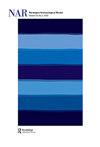Writing the Past. Knowledge and Literary Production in Archaeology
IF 1.1
3区 历史学
0 ARCHAEOLOGY
引用次数: 11
Abstract
Around the middle of the last century a number of archaeological practices were described as being ‘empiricist’. This description was applied to those practices that appeared to employ the assumption that because material residues recorded, and thus represented, the processes that were involved in their formation, then by describing those materials their formation processes were also described, and thus the ‘past’ was revealed. This view was challenged by arguing that archaeology should do more than simply describe the formation of the particular things that had existed in the past, and seek instead to explain, in more general terms, the reasons why certain assemblages of things had come about. The move was therefore one that took archaeology from the study of the particular influences to explanations formulated in terms of general processes. The emphasis of this kind new of archaeology was towards explaining ‘culture change’, in which it was assumed that an explanation should specify the causes for the changes that had occurred amongst the different kinds of cultural systems. It was these systems that were taken to be represented by archaeological assemblages of things. Throughout this debate the issue that tended to be forgotten was the ways that the protagonists were using language. This was not a concern with the unknown languages of the past, but the present-day languages by which knowledge claims were being sustained and communicated. This issue came down to the ways that the relationships between things were being expressed in words. Clearly general causes are unlikely to be expressed as if they were self-evident. It was therefore accepted that causes needed to be thought about and to be modelled ‘theoretically’, and, by this means, they also needed to be evaluated. Archaeological theorists dismissed any lingering desire for an empiricist reading of the material by means of the languages that they used, and their theoretical modelling sought to identify the general reasons why certain historical processes might have existed. For example, variability in artefact assemblages could now be described as variability in tool kits, a variability that had been designed for the different tasks demanded by the processes of environmental adaptation, rather than that same variability being treated as if it had resulted from an ethnically transmitted tradition of artefact production. A theoretically informed archaeology was thus developed in the latter half of the twentieth century. Because the theoretical modelling of formation processes assumed that the past had been structured by a more limited set of processes than might have been implied by the diversity of its material remains, then these structuring processes were described in the relatively abstract languages of theory. Archaeology developed the skills to record the particular nature of the material diversity of the past by the use of a traditional ‘cultural’ labelling, whilst at the same time developing the analytical languages that could describe the more general processes that were believed to have brought about that diversity. It is the relationship between the two traditions of languageuse, widely expressed in traditions of archaeological writing, that Gavin Lucas seeks to explore in this book. Lucas suggests that archaeologists do in fact spend most of their working lives writing (and reading), and that what they write (and what they read, and what they copy) concerns the way that they are able to communicate their understandings of the links between the material diversity they recover today, and the general processes that they believe had once operated in the past. This means that written styles must exist that carry the work of description into the work of interpretation and explanation. The written styles of explanation presumably carry within them certain theoretical prejudices that claim to书写过去。考古学中的知识与文学生产
大约在上世纪中叶,许多考古实践被描述为“经验主义”。这一描述适用于那些似乎采用了这样一种假设的实践,即由于材料残留物记录并代表了其形成过程,因此通过描述这些材料,也描述了其形成的过程,从而揭示了“过去”。这一观点受到了质疑,认为考古学应该做的不仅仅是简单地描述过去存在的特定事物的形成,而是寻求更笼统地解释某些事物组合产生的原因。因此,这一举措将考古学从对特定影响的研究转向了根据一般过程制定的解释。这种新考古学的重点是解释“文化变化”,在这种解释中,人们认为解释应该具体说明不同类型文化系统之间发生变化的原因。正是这些系统被认为是由事物的考古组合所代表的。在这场辩论中,人们往往会忘记主角使用语言的方式。这与过去未知的语言无关,而是与维持和传播知识主张的当今语言有关。这个问题归结为事物之间的关系用语言表达的方式。显然,一般原因不太可能像不言自明那样被表达出来。因此,人们普遍认为,需要从“理论上”思考和建模原因,通过这种方式,也需要对其进行评估。考古理论家们摒弃了通过他们使用的语言对材料进行经验主义阅读的任何挥之不去的愿望,他们的理论建模试图找出某些历史过程可能存在的一般原因。例如,人工制品组合的可变性现在可以被描述为工具包的可变性,这种可变性是为环境适应过程所需的不同任务而设计的,而不是将同样的可变性视为人工制品生产的种族传承传统的结果。因此,在二十世纪下半叶发展了一种理论上知情的考古学。由于形成过程的理论建模假设过去是由一组比其物质遗迹的多样性所暗示的更有限的过程构成的,因此这些结构过程是用相对抽象的理论语言描述的。考古学通过使用传统的“文化”标签,发展了记录过去物质多样性的特殊性质的技能,同时发展了分析语言,可以描述人们认为导致这种多样性的更普遍的过程。加文·卢卡斯在本书中试图探讨的是两种语言使用传统之间的关系,这两种传统在考古写作传统中得到了广泛表达。卢卡斯认为,事实上,考古学家的大部分工作时间都在写作(和阅读),他们写什么(读什么,抄什么)关系到他们能够传达他们对当今恢复的物质多样性与他们认为过去曾经运作过的一般过程之间联系的理解。这意味着必须存在将描述工作带入解释和解释工作的书面风格。书面的解释风格可能带有某些理论偏见,声称
本文章由计算机程序翻译,如有差异,请以英文原文为准。
求助全文
约1分钟内获得全文
求助全文
来源期刊

Norwegian Archaeological Review
ARCHAEOLOGY-
CiteScore
2.10
自引率
0.00%
发文量
13
期刊介绍:
Norwegian Archaeological Review published since 1968, aims to be an interface between archaeological research in the Nordic countries and global archaeological trends, a meeting ground for current discussion of theoretical and methodical problems on an international scientific level. The main focus is on the European area, but discussions based upon results from other parts of the world are also welcomed. The comments of specialists, along with the author"s reply, are given as an addendum to selected articles. The Journal is also receptive to uninvited opinions and comments on a wider scope of archaeological themes, e.g. articles in Norwegian Archaeological Review or other journals, monographies, conferences.
 求助内容:
求助内容: 应助结果提醒方式:
应助结果提醒方式:


